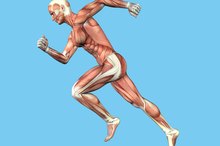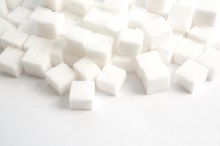How Does Insulin Signal a Cell to Take in Glucose from the Blood?
Biological Signals
Just as we receive and act on signals from our environment, our cells also receive and act on signals from their environment, our bodies. This is a necessary biological occurrence that keeps cells alive and functioning. Insulin is a hormone released by our pancreas that signals cells in a specific way in order to stimulate them to take in, use and store glucose.
Function of Insulin
Enzymes That Break Down Fat Cells
Learn More
After ingesting food, your meal is broken down and digested. As a result, glucose is released into your bloodstream. High concentrations of glucose in the blood are a signal for the beta cells of the pancreas to release insulin. This hormone works like a key to unlock the protective cell membranes and allow the passage of glucose into the cell to be used for energy.
- After ingesting food, your meal is broken down and digested.
- High concentrations of glucose in the blood are a signal for the beta cells of the pancreas to release insulin.
Mechanism of Insulin
Insulin works to decrease the concentration of glucose in the blood and facilitate transport into the cells by binding to special receptors embedded in their membranes. Although there are some tissues such as the brain and the liver that do not require insulin for glucose uptake, most of our cells would not be able to access blood glucose without it. Glucose is the energy source for all cells and is required for their, and ultimately our, survival.
The insulin signaling pathway includes an insulin receptor that is made up of two receptor subunits that are located on the outside of the cell membrane and two subunits that penetrate through the membrane. These subunits are chemically bonded together. The extracellular (outside the cell) subunits contain a binding site for insulin. When insulin binds to the extracellular subunits, it activates a chemical reaction that travels through the linked subunits into the cell. This mechanism sends chemical signals to proteins within the cell and causes them to alter their activity, which in turn initiates the movement of glucose transporters to the cell membrane.
Glucose transporters are the cells' method for transferring glucose through the cell membrane from the blood and into the cell. The glucose transporters are ever present inside organelles called vesicles within the cells' cytoplasm. However, they are useless to transport glucose without activation from insulin. The binding of insulin to the cell leads to a rapid movement of the vesicles to the cell membrane, where they fuse with it and insert the glucose transporters. This gives the cell the ability to open itself to the transfer of glucose from the blood. When blood glucose levels decline, insulin ceases to bind to the cell receptors and the glucose transporters are moved back into the cell’s cytoplasm.
- Insulin works to decrease the concentration of glucose in the blood and facilitate transport into the cells by binding to special receptors embedded in their membranes.
- The binding of insulin to the cell leads to a rapid movement of the vesicles to the cell membrane, where they fuse with it and insert the glucose transporters.
Related Articles
References
- University of Colorado
- U.S. Centers for Disease Control and Prevention. Insulin resistance and diabetes. Last reviewed August 12, 2019.
- Wilcox G. Insulin and insulin resistance. Clin Biochem Rev. 2005;26(2):19–39.
- Ritchie RH, Zerenturk EJ, Prakoso D, Calkin AC. Lipid metabolism and its implications for type 1 diabetes-associated cardiomyopathy. J Mol Endocrinol. 2017 May;58(4):R225-R240. doi:10.1530/JME-16-0249
- Volpi, E. and Dickinson, J.M. (2015). Protein metabolism in health and diabetes. In International Textbook of Diabetes Mellitus (eds R.A. DeFronzo, E. Ferrannini, P. Zimmet and K.G.M.M. Alberti). doi:10.1002/9781118387658.ch16
- Colorado State University. Pathophysiology of the Endocrine System. Physiologic effects of insulin.
- University of Berkley, California. Endocrine Pancreas.
Writer Bio
Robin Jagoda has more than a decade of experience as a fitness/health professional and writer. She is certified as a clinical exercise specialist with the American College of Sports Medicine and holds a B.S. in exercise physiology. Jagoda is also a registered respiratory therapist with the National Board for Respiratory Care.









